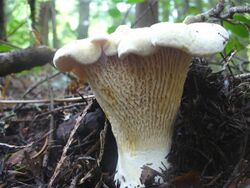Biology:Cantharellus subalbidus
| Cantharellus subalbidus | |
|---|---|

| |
| Scientific classification | |
| Domain: | Eukaryota |
| Kingdom: | Fungi |
| Division: | Basidiomycota |
| Class: | Agaricomycetes |
| Order: | Cantharellales |
| Family: | Cantharellaceae |
| Genus: | Cantharellus |
| Species: | C. subalbidus
|
| Binomial name | |
| Cantharellus subalbidus | |
| Cantharellus subalbidus | |
|---|---|
| Mycological characteristics | |
| ridges on hymenium | |
| cap is infundibuliform | |
| hymenium is decurrent | |
| stipe is bare | |
| spore print is white | |
| ecology is mycorrhizal | |
| edibility: choice | |
Cantharellus subalbidus, the white chanterelle, is a fungus native to California and the Pacific Northwest region of North America. It is a member of the genus Cantharellus along with other popular edible chanterelles. It is similar in appearance to other chanterelles except for its cream to white color and orange bruising.[1]
Cantharellus subalbidus may form a mycorrhizal association with species of pine, hemlock, Douglas-fir, and Pacific madrone.[2][3][4] C. subalbidus has been found to be more common in old-growth forests than in younger forests.[5]
Description
The mushroom is white to cream in color,[6] later darkening to yellow-orange.[2] The cap is 5–15 cm (2–6 in) wide, flat to depressed, becoming infundibuliform (vaselike) with age.[6] The stalk is 2–7 cm tall and 1–5 cm wide, tapered, with yellow-brown spots due to bruising and age.[6] The spores are white, elliptical, and smooth.[6]
Similar species
Several other species of chanterelle may be found in western North America:
- C. californicus
- C. cascadensis[7]
- C. cibarius var. roseocanus
- C. formosus[7]
Additionally, Leucopaxillus albissimus,[6] Hygrophoropsis aurantiaca, Chroogomphus tomentosus, and species in the genera Craterellus, Gomphus, Omphalotus, and Polyozellus may have a somewhat similar appearance to C. subalbidus.
Uses
A choice edible, they can be prepared by being sautéed or cutting into chunks and baking at 350 °F (177 °C) for 10 minutes.[7]
References
- ↑ Plischke, J. (March 2004). "Cantharellus subalbidus: The white chanterelle". MushroomExpert.com. http://www.mushroomexpert.com/cantharellus_subalbidus.html. Retrieved 13 September 2010.
- ↑ 2.0 2.1 Trudell, S.; Ammirati, J. (2009). Mushrooms of the Pacific Northwest. Timber Press Field Guides. Portland, OR: Timber Press. p. 45. ISBN 978-0-88192-935-5. https://books.google.com/books?id=WevHvt6Tr8kC.
- ↑ Wood, Michael; Stevens, Fred. "California Fungi—Cantharellus subalbidus". mykoweb.com. http://www.mykoweb.com/CAF/species/Cantharellus_subalbidus.html. Retrieved 14 September 2010.
- ↑ Arora, David (1986). Mushrooms Demystified: A Comprehensive Guide To The Fleshy Fungi (2nd ed.). Berkeley: Ten Speed Press. p. 662. ISBN 0-89815-169-4. https://archive.org/details/mushroomsdemysti00aror_0/page/662.
- ↑ Dunham, Susie M.; O'Dell, Thomas E.; Molina, Randy (2006). "Forest stand age and the occurrence of chanterelle (Cantharellus) species in Oregon's central Cascade Mountains". Mycological Research 110 (12): 1433–40. doi:10.1016/j.mycres.2006.09.007. PMID 17123812. Archived from the original on 2011-08-14. https://web.archive.org/web/20110814100759/http://ddr.nal.usda.gov/bitstream/10113/13297/1/IND44024112.pdf.
- ↑ 6.0 6.1 6.2 6.3 6.4 Davis, R. Michael; Sommer, Robert; Menge, John A. (2012). Field Guide to Mushrooms of Western North America. Berkeley: University of California Press. pp. 272–273. ISBN 978-0-520-95360-4. OCLC 797915861. https://www.worldcat.org/oclc/797915861.
- ↑ 7.0 7.1 7.2 Meuninck, Jim (2017). Foraging Mushrooms Oregon: Finding, Identifying, and Preparing Edible Wild Mushrooms. Falcon Guides. p. 5. ISBN 978-1-4930-2669-2.
External links
- Cantharellus subalbidus in Index Fungorum
- "Key to Pacific Northwest CHANTERELLES, Chanterelle-Like Mushrooms, and Look-Alikes". Pacific Northwest Key Council. 2003. http://www.svims.ca/council/Chante.htm. Retrieved 2011-03-22.
Wikidata ☰ Q4035836 entry
 |

